- Testimonials


What is a rhetorical précis?
A précis is a highly structured summary of a text, focusing on the text’s argument and presentation. It is a type of academic writing presenting factual information only, without opinions of the précis writer.

The opening sentence names the text, its author, genre and publication date followed by a clause naming the thesis of the work.
The second sentence explains how the author develops the thesis, with information usually presented in the same order as in the original text.
The third sentence explains why the text was written, often followed by an “in order to” phrase.
The fourth sentence either describes the intended audience or the tone of the text.
Let’s look at a précis I wrote about the Declaration of Independence:
In the Declaration of Independence (July 1776), Thomas Jefferson argues that because King George III usurped the liberties of British citizens in the North American colonies, those citizens were declaring their independence from Britain. Jefferson divides the Declaration into four parts: the preamble, a short paragraph explaining that the world has a right to know why the colonies are separating; second, the most quoted part, the philosophical justification for the separation; third, the longest section, the list of grievances against King George III; and fourth, another short paragraph declaring independence. Jefferson’s purpose was to present a logical and legally sound justification for the separation in order to gain the support of all 13 colonies and of potential international allies. The author’s tone is formal as befits the seriousness of the purpose.
Why are students asked to write a précis? A précis demands summarizing, analyzing and culling a text into a concise format, eliminating opinion. Writing a good précis proves whether a student understands a text and whether a student can write.
Share this:
- Click to share on Facebook (Opens in new window)
- Click to share on Pinterest (Opens in new window)
- Click to share on Twitter (Opens in new window)
- Click to email a link to a friend (Opens in new window)
What's your thinking on this topic? Cancel reply
One-on-one online writing improvement for students of all ages.

As a professional writer and former certified middle and high school educator, I now teach writing skills online. I coach students of all ages on the practices of writing. Click on my photo for more details.

You may think revising means finding grammar and spelling mistakes when it really means rewriting—moving ideas around, adding more details, using specific verbs, varying your sentence structures and adding figurative language. Learn how to improve your writing with these rewriting ideas and more. Click on the photo For more details.

Comical stories, repetitive phrasing, and expressive illustrations engage early readers and build reading confidence. Each story includes easy to pronounce two-, three-, and four-letter words which follow the rules of phonics. The result is a fun reading experience leading to comprehension, recall, and stimulating discussion. Each story is true children’s literature with a beginning, a middle and an end. Each book also contains a "fun and games" activity section to further develop the beginning reader's learning experience.
Mrs. K’s Store of home schooling/teaching resources

Furia--Quick Study Guide is a nine-page text with detailed information on the setting; 17 characters; 10 themes; 8 places, teams, and motifs; and 15 direct quotes from the text. Teachers who have read the novel can months later come up to speed in five minutes by reading the study guide.
Post Categories
Follow blog via email.
Enter your email address to follow this blog and receive notifications of new posts by email.
Email Address:
Peachtree Corners, GA
- Already have a WordPress.com account? Log in now.
- Subscribe Subscribed
- Copy shortlink
- Report this content
- View post in Reader
- Manage subscriptions
- Collapse this bar
Rhetorical Precis Guide
How To Write A Precis
Last updated on: Jun 9, 2023
How to Write A Precis: Step-by-Step Guide
By: Nova A.
Reviewed By: Chris H.
Published on: Aug 17, 2021

You’re sitting in class daydreaming, and suddenly you hear the Professor assigning homework.
He’s talking about writing a precis.“What is a precis?”If you’re on the internet trying to figure out how to get your assignment done, then congratulations, you are at the right place.
"A precis is a summary of an article or book. It should summarize the main points and include any major themes, ideas, or conclusions."
Do you want to know how to write a precis? If so, keep reading! This post will provide you with step-by-step instructions on how to do it.

On this Page
Definition of Precis
What is a precis? It is derived from the French word précis, which means “a concise summary.” Thus, the literal meaning of the term is precise or cut short.
Unlike a summary that condenses and presents the main ideas only, a precis presents every detail and should be one-third of the original text. It is a clear and to-the-point summary of the key ideas of a passage, but it is more detailed than a summary.
It isn’t merely a paraphrased text. When asked to write a precis summary, ensure that the key points are reflected along with its tone and mood, etc.
The key to writing a précis is simplicity. You may be given an scholarly article or dissertation summary, but your job isn't just about summarizing.
Instead, you need to analyze and present the main points concisely in your words so that readers can make up their own minds with what they read!
Let’s move on to the next section to see how to write a precis?

Paper Due? Why Suffer? That's our Job!
Characteristics of a Precis
Following are the characteristics of a precis:
- It is a critical summary of a published piece of writing.
- Not a re-written version of the original piece.
- Written in your own words and not in words from the original piece unless you are quoting it.
- Its length is 1/3rd of the length of the original piece unless you are told otherwise by the professor.
- A precis format includes the thesis that the original author supports, methods he used, results and conclusion.
Qualities of a Precis
A precis is a critical piece of writing. Make sure that yours has the following qualities.
- It should be well-written so the reader can easily understand what you are trying to convey. Use clear and simple language.
- It must be correct and error-free, add correct facts and figures, and check for grammatical and punctuation mistakes.
- Stay objective; only provide useful information and not your personal opinion.
- It should be coherent with the original text.
- Keep it concise; avoid adding unnecessary information.
Elements of Precis
Following are the essential elements of a precis:
A reader should understand what the writer wants to say. A precis is a short summary of the story. It should be easy for people to understand.
- Correctness
When you write a precis, you should look for punctuation, grammar, and sentence structure mistakes. You should also double-check all of the dates, addresses, facts, and figures that were used.
- Objectivity
Being objective means telling the truth about your information. It means that you should only talk about facts and not give your opinion.
- Conciseness
When you are writing a summary, you want it to be concise. Therefore, you should avoid repeating things and using unnecessary words.
Coherence is making sense. Say what you want to say, but make it clear. Your audience does not want to get lost or confused when they read. Use strong words that help them understand better.
Precis Format
Precis outline is similar to an essay; it consists of an introduction, body paragraphs, and conclusion.
- Introduction
The introduction consists of information about:
- Publishing date within parenthesis
- A verb to represent the thesis
- The thesis statement
The body of the precis has separate paragraphs dedicated to each section of the original piece of work where you present the author’s thoughts, ideas, and purpose.
Don’t forget that you can’t give your own opinion or interpretation. Instead, your focus should be to analyze the author’s take on the main idea or issue.
With your conclusion, simply restate the main idea without any personal statements.
PRECIS TEMPLATE (PDF)
How to Write a Rhetorical Precis?
Before starting the writing process, keep in mind that your precis should be able to make the reader understand the original work without having read it.
As with any other academic writing, start by conducting thorough reading and research. Just because it is a small piece of writing doesn’t necessarily mean that it will be easy or quick.
The essay writing process can be divided into examining the original work, creating a structure, and the writeup itself.
To find out how to write a precis, let us discuss the steps in detail:
1. Read the Content
To write a good rhetorical precis, you need to read the original text. You can do this in two ways. First, skim over the text but try to remember it all. Second, look at where it was published and what section is most important.
Take notes about what is said in the title and figure out what the document’s content might be about. Then, when you are done skimming, take notes with key ideas and respond to those ideas with strategies that the author used to persuade people.
2. Draft an Outline
An outline makes it easier to write. It also helps readers understand what you are writing about. Once you get all the information, put it in four sentences that have an introduction, body, and conclusion.
3. Write your Precis
After creating an outline, start writing the precis. Make sure to follow the format discussed above. Start with the introduction paragraph, then provide supporting body paragraphs, and at last provide a conclusion.
Make sure to follow your outline while writing so that you do not miss any important detail.
4. Proofread
Take a break from writing your precis to make sure it is free of mistakes. Once you are done, read it again and fix any errors before submitting the document to your instructor. Your credibility will be reflected in how accurate your work is.
Tough Essay Due? Hire Tough Writers!
How to Write a Precis - Example
It is important to go through examples before you start writing it yourself, as it will give you an idea of how to start writing your own precis.
PRECIS EXAMPLE (PDF)
RHETORICAL PRECIS WORKSHEET
RHETORICAL PRECIS SAMPLE
Precis Writing Tips
To write a winning rhetorical precis, follow the tips mentioned below:
- Read the text under critical analysis carefully and note down the essential points and arguments. Then, try different reading practices to better understand the work.
- Focus on what the author is trying to communicate through his work.
- Point out the evidence and appeals used by the author.
- Restate the thesis stated by the author in your words according to your interpretation. Remember to keep it short and to the point.
- The key is to describe the original piece in your own words.
- Go through the summary again to ensure you haven’t missed any important points and used a logical structure.
- Before handing in your document, make sure that it is clear and concise without any grammatical errors.
- When it comes to writing a precis, you need to cite the attributes taken directly from the piece under analysis.
- Also, keep in mind that teachers only assign a precis to check how well students can communicate their thoughts and want them to develop critical thinking and writing skills.
So now that you have read this blog, we hope that you found the answer to your question "How to write a precis?" If not, then there are other ways of getting help. You can get professional essay writing service from 5StarEssays.com .
Our expert writers will help you come up with an exceptional precis worthy of impressing your professor of English and literature at the most affordable rates.
Place your order now!
Frequently Asked Questions
What is the best way to write a precis.
Precis is a summary of something complex. A good precis can be written as follows:
- Read the information and note down the important points
- Summarize those points in simple words
- Polish it to make a final draft
How long is a precis?
A precis is about 100-200 words. It is a shortened version of the original text. Sometimes, your teacher will tell you the word count for a precis or give other instructions on writing it.
In which person, a precis is written?
Precis writing is a third-person account of the subject matter. It starts with the author says and includes paraphrases instead of direct quotes. As a result, it’s easier to read for someone who may not know how to quote directly in an argument or essay.

Thesis, Marketing
As a Digital Content Strategist, Nova Allison has eight years of experience in writing both technical and scientific content. With a focus on developing online content plans that engage audiences, Nova strives to write pieces that are not only informative but captivating as well.
Was This Blog Helpful?
Keep reading.
- Learn How to Write a Rhetorical Precis Like Experts

People Also Read
- argumentative essay characteristics
- argumentative essay examples
- what is a topic sentence
- persuasive essay topics
- press release example
Burdened With Assignments?

Advertisement
- Homework Services: Essay Topics Generator
© 2024 - All rights reserved

- My presentations
Auth with social network:
Download presentation
We think you have liked this presentation. If you wish to download it, please recommend it to your friends in any social system. Share buttons are a little bit lower. Thank you!
Presentation is loading. Please wait.
To view this video please enable JavaScript, and consider upgrading to a web browser that supports HTML5 video
Writing the Rhetorical Precis
Published by Jemima Parsons Modified over 9 years ago
Similar presentations
Presentation on theme: "Writing the Rhetorical Precis"— Presentation transcript:
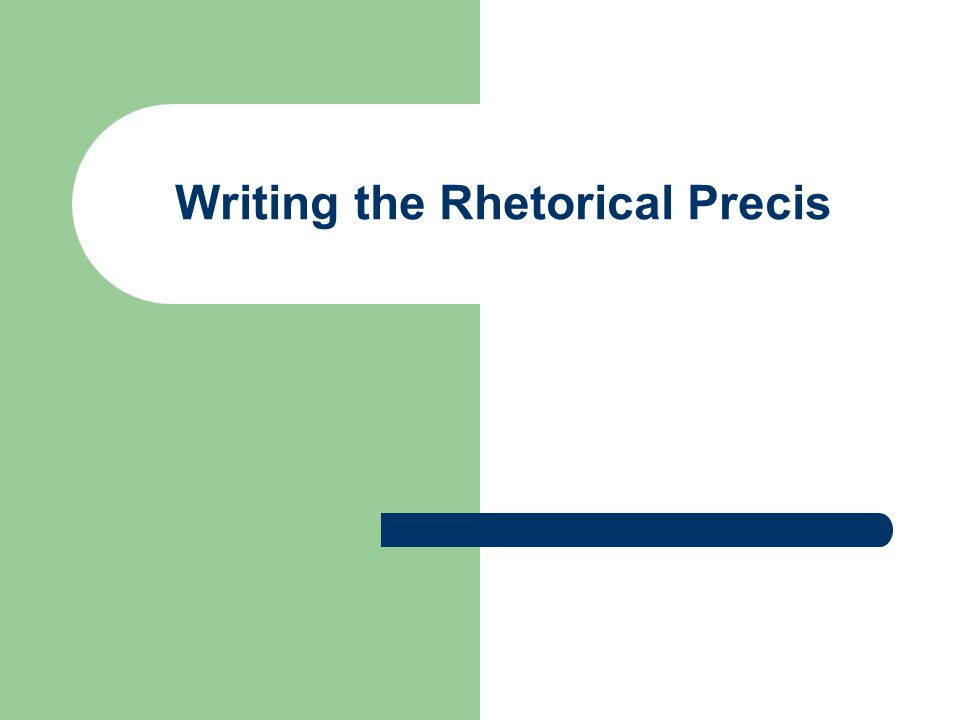
Elements of an Argument

How to write a rhetorical analysis

How to write a Precis A précis (pray-see) is a brief summary that follows a specific format. 1) A single sentence which includes the author, title, date.

AP Language and Composition Columnist Project Argument Essay Ms. A. Martin, M.ED.

Sample for “Civil Disobedience”

“The Hobbit” Précis ELACC7W9: I can draw evidence from literary texts to support analysis and reflection ELACC7RL2: I can provide an objective summary.

Think like a professional writer Writers use rhetorical skills to construct meaning. Rhetoric: speech or writing that communicates its point persuasively.

Rhetorical Analysis Essay

FUN WITH THE Rhetorical Pr é cis. Rhetorical Précis A four-sentence paragraph that records essential rhetorical elements Combines summary and analysis.

Summary and Rhetorical Précis

The Writing Process Introductions and theses. What is an introduction? Opening paragraph of an essay Purpose is to present the reader with information.

Language, Gender and Culture

Writing A Rhetorical Precis Jennifer Romanowski. Assessing Reading Multiple choice tests Open ended questions Summary Rhetorical Precis All of these may.

Rhetorical Essay Moments in history, social views, and the national audience contribute to the rhetorical choices made by the speaker. Authors use rhetorical.

Sample for “Promiscuous”

Juvenile Justice Texts “Kids are Kids—Until They Commit Crimes”

Writing the Rhetorical Precis Jean G. Ellerhoff Central Academy Des Moines, Iowa.

Rhetorical Precis A précis is a concise summary of a work. When the work is rhetoric, the precis is called a rhetorical precis.
About project
© 2024 SlidePlayer.com Inc. All rights reserved.

Rhetorical Precis
Jul 19, 2014
160 likes | 800 Views
Rhetorical Precis. A précis helps to ensure that you will be engaged with the texts. (Précis – pronounced pray-see - means summary of a text) What is a Rhetorical Précis?
Share Presentation
- homework disrupts
- fourth sentence
- thesis statement
- effective teaching method
- rhetorically accurate

Presentation Transcript
Rhetorical Precis A précis helps to ensure that you will be engaged with the texts. (Précis – pronounced pray-see - means summary of a text) What is a Rhetorical Précis? A précis is a four sentence paragraph that records the essential elements of an essay. Each of the four sentences requires specific information.
Sentence 1 • Name of author [optional: a phrase describing author], genre and title of work date in parentheses; a rhetorically accurate verb (such as "assert," "argue," suggest," "imply," "claim," etc.); and a THAT clause containing the major assertion (thesis statement) of the work. Think of it this way: WHO are you talking about? WHAT is their background? WHAT did they write? WHAT year was it written? WHAT is their point?
Second Sentence An explanation of the evidence and development the author uses to develop and/or support the thesis, usually in chronological order. Think of it this way: H O W do they prove their thesis? Do they offer interviews? Official data? Other outside sources? Anecdotes?
Third Sentence A statement of the author's purpose followed by an "in order" phrase. Think of it this way: Are they trying to entertain you? Persuade you to feel a certain way or change your mind about an issue? Are they trying to inform you – sharing information that teaches - ? WH Y is that their purpose? In order to accomplish what?
Fourth Sentence A description of the intended audience and/or the relationship the author establishes with the audience. Think of it this way: WHO is the author trying to address? For example, are they talking to teachers? parents? senior citizens? Latinos? Muslims? registered voters? It can be anyone. You need to determine if they are addressed formally (use of academic language, proper English) or informally (more conversational tone, use of slang, etc…).
Example In the article “End Homework Now” (2001), Etta Kralovec and John Buell claim that the practice of assigning homework is not an effective teaching method because its negative effects outweigh its benefits. Kralovec and Buell support their claims by providing examples of how homework disrupts families, overburdens children and limits learning and by dispelling myths about the benefits of homework and providing alternative practices that would lead to improvement in student achievement. The authors’ purpose is to make the reader question a practice that is a trademark of the U.S. education system and decide whether it is conducive to creating a “smarter” student. They seem to be speaking to the entire educational community: administrators, teachers, students and parents.
- More by User

Rhetorical Analysis
Steps to a Close Read. Read the passage and annotate. Look for the required rhetorical devices.After locating the devices in the speech:Ask why the device was used (what was the purpose?)Ask what effect the device and purpose would have on the intended audience.Develop a thesis:A road map for
360 views • 14 slides
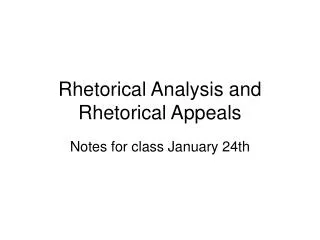
Rhetorical Analysis and Rhetorical Appeals
Rhetorical Analysis and Rhetorical Appeals. Notes for class January 24th. Motives for Writing Introduction: Writing for Your Life. Introduction Writing is a skill that can be learned with effort over time.
485 views • 16 slides
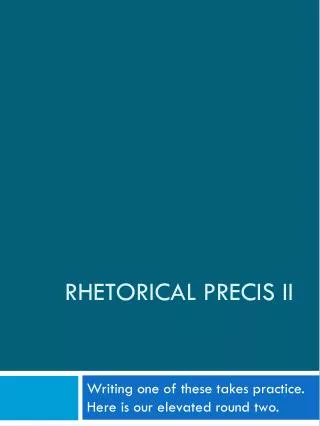
Rhetorical Precis II
Rhetorical Precis II. Writing one of these takes practice. Here is our elevated round two. . When you see a pizza delivery person, what do you think? . Is she working for gas money?. Or is she struggling to support three kids and pay the rent ?.
413 views • 20 slides
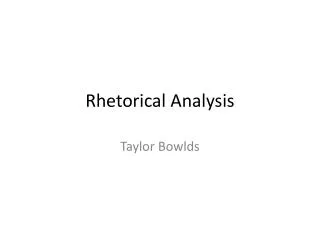
Rhetorical Analysis. Taylor Bowlds. Aware Helpline.
364 views • 12 slides

Rhetorical Strategies
Rhetorical Strategies. Group 4 Lucy, Katie, Kennedi, and Jackie. Repetition. Definition: repetition of sounds, words, phrasing, or concepts used in literary works to create unity & emphasis
358 views • 9 slides
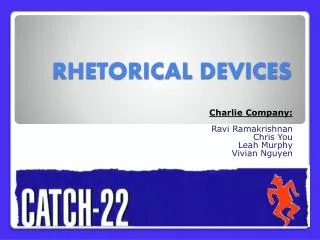

RHETORICAL DEVICES
RHETORICAL DEVICES. Charlie Company: Ravi Ramakrishnan Chris You Leah Murphy Vivian Nguyen. The Chaplain and Colonel Korn: “The chaplain was not certain at which of the five officers’ and five enlisted men’s mass halls… grounds in disjuncted relationships.” (200/210)
257 views • 13 slides
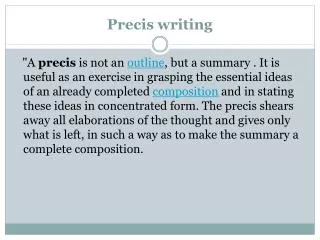
Precis writing
Precis writing.
4.91k views • 9 slides
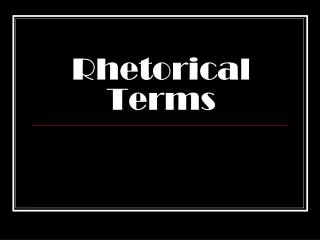
Rhetorical Terms
Rhetorical Terms. ALLUSION. To refer to indirectly. Anadiplosis. The repetition of the last word of one clause at the beginning of the following clause. See Sentence Variation Packet for example
664 views • 34 slides

Rhetorical Devices
Rhetorical Devices. Anaphora Anecdote Antanaclasis Antanagoge Antimetabole. Anaphora. [uh- naf - er -uh] F rom the Greek, “carrying back ” R hetorical term for the repetition of a word or phrase at the beginning of a successive clauses
334 views • 7 slides
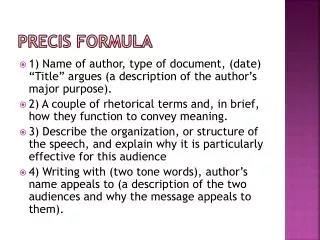
Precis Formula
Precis Formula. 1) Name of author, type of document, (date) “Title” argues (a description of the author’s major purpose). 2) A couple of rhetorical terms and, in brief, how they function to convey meaning.
334 views • 4 slides

Rhetorical Devices. By Isabel Lewis. Irony.
426 views • 7 slides
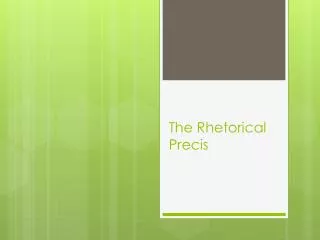
The Rhetorical Precis
The Rhetorical Precis. Purpose. The purpose of the precis is to give as much information as possible in four sentences. The precis answers the basic who, what, where, when, how, why, and to whom about the rhetorical situation of the discourse. #1. Name of the author
795 views • 10 slides
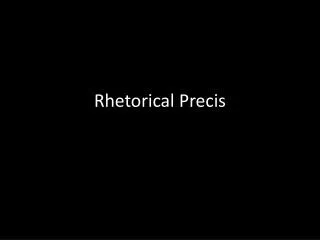
Rhetorical Precis. PRECIS FORMAT. 1)– T. A. G., (year of publication), verb + “that” (THESIS) 2) – How + 3 Textual Evidence (quotes) 3) – Author’s purpose + “in order to…” 4) – Intended Audience +/ tone MLA Citation at bottom.
317 views • 7 slides

The Rhetorical Precis. Figuring out how they did it…. * highly specialized, specific kind of summary * emphasis placed on the rhetorical aspects * FOUR PREDETERMINED SENTENCES – to help you get started on your writing! .
520 views • 21 slides

Lecture -6 Precis writing
Lecture -6 Precis writing. Course: English writing skills September 3 rd week 2013. PRECIS WRITING ( pronunciation Pray-See). A Precis is also known as a summary. A brief summary of a book, a rticle , speech , or other text .
3.46k views • 57 slides

Rhetorical Devices. Used in Persuasion . Oratory/ Orator. A form of public speaking A qualified speaker Contents of speech to add emphasis include: Charged Words Rhetorical questions Restatement Repetition Parallelism Exclamation. Charged Words.
376 views • 9 slides

Rhetorical Strategies. Narrative of the Life of Frederick Douglass. Frederick Douglass (1818-1895). “I was born in Tuckahoe, near Hillsborough, and about twelve miles from Easton, in Talbot county, Maryland” (19). Personal Narrative.
487 views • 33 slides
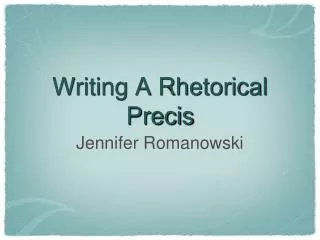
Writing A Rhetorical Precis
Writing A Rhetorical Precis. Jennifer Romanowski. Assessing Reading. Multiple choice tests Open ended questions Summary Rhetorical Precis All of these may be an appropriate formative* assessment of reading.
291 views • 12 slides
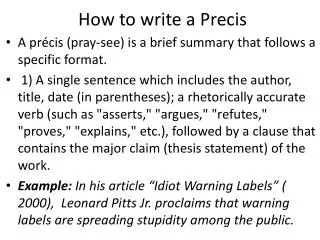
How to write a Precis
How to write a Precis. A précis (pray-see) is a brief summary that follows a specific format.
714 views • 7 slides
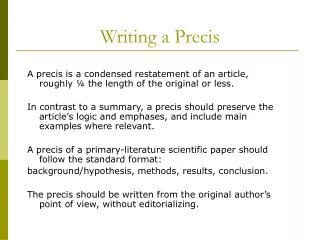
Writing a Precis
A precis is a condensed restatement of an article, roughly ¼ the length of the original or less. In contrast to a summary, a precis should preserve the article’s logic and emphases, and include main examples where relevant.
351 views • 4 slides
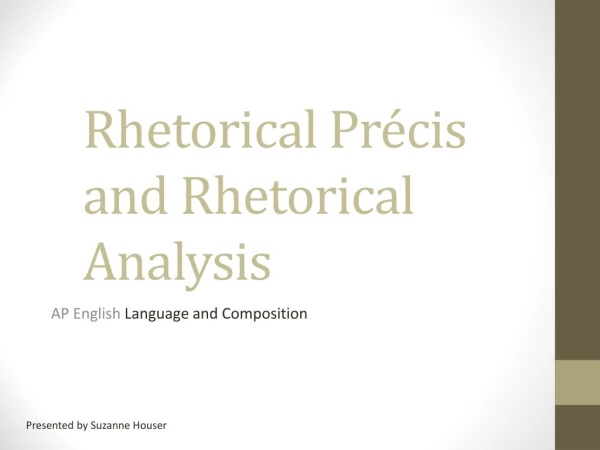
Rhetorical Précis and Rhetorical Analysis
Rhetorical Précis and Rhetorical Analysis. AP English Language and Composition. Presented by Suzanne Houser. What is a Rhetorical Précis ?. a highly specialized, specific type of summary
318 views • 29 slides
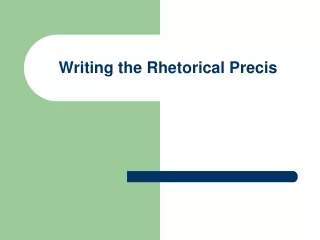
Writing the Rhetorical Precis
Writing the Rhetorical Precis. The Rhetorical Precis. The precis is a highly structured four sentence paragraph that records the essential elements of a unit of spoken or written discourse. Each of the four sentences requires specific information. The Rhetorical Precis Format. Sentence 1
189 views • 8 slides
- LIVE CHAT Login
How to Write a Rhetorical Precis: Template, Steps & Example
What is a precis.
A precis is a summarizing method in which the author maintains the meaning, proportions, and tone of the original text. In other words, precis refers to a summary of a reading one has completed. Writing a precis requires a lot of work, starting with reading and brainstorming on other people’s work.
The length of a precis is not strictly defined and as such, it can vary greatly. In most cases, a precis is 100 to 200 words long or approximately, it takes one-fifth or one-sixth of the original reading’s size.
Even though this is basically a summary, there’s a difference between the two terms. In summaries, the writers cover the main points of the text in a more succinct manner, while in precis, the size of the content is at least 1/3 of the total words from the original content.
To be more, a summary takes a broader approach toward the main events and is more generalized. Precis writing, on the other hand focuses on details and analyzes the situations more thoroughly.
What is a Rhetorical Precis?
A rhetorical precis is an analytical, less neutral summary of the content, as well as methods found in the original text. If summary is a brief representation of the original text, this is a representation of two things – what’s said and done in the original text.
Generally speaking, summaries are far more widely used and assigned than rhetorical precis. Even so, chances are you’ll be asked to write at least one precis during your studies, which makes it crucial for you as a student to learn how to write a rhetorical precis.
This is a type of academic writing that recapitulates the main arguments, ideas, and points of the selected work. In it, the primary goal of the author is to provide the most accurate details about the text in question. In a couple of paragraphs, precis writing must analyze the text itself, as well as the delivery of written discourse, all while answering questions such as ‘’how’’, ‘’what’’, and ‘’why’’.
Rhetorical Precis Structure
Academically speaking, the rhetorical precis structure includes the following elements:
- Introduction
- Body paragraphs
Basically, it has an essay structure where the introduction ends with a thesis statement, and the body paragraphs summarize the main arguments and concepts.
If you want to learn how to write a rhetorical precis, one essential thing to know is the widely-accepted, 4-part structure of this assignment. A four sentence precis is basically a guide that helps you include the four key elements this assignment requires. They are:
- First sentence includes: name of the author, date in parenthesis, title of the work, a rhetorical verb, and a that clause (one that contains the thesis statement of your work).
- Second sentence gives an explanation of how you supported and developed the thesis statement i.e. your that clause claim.
- Third sentence gives a statement of your purpose and uses an ‘’ in order’’ phrase.
- Fourth sentence describes the relationship of the author with the intended audience.
How to Write a Rhetorical Precis? Step by Step Guide
If you haven’t written this type of paper before, you probably have no idea how to start a precis – or finish it afterward. This is why we’ve created a short guide, a list of steps that will help students understand how to write a rhetorical precis.
Step 1: Introductory paragraph
The introduction of a rhetorical precis starts with an attention-grabbing, summary-like statement. The following sentences, usually one or two, provide the central claims presented by the author, as well as the context of the composition. Lastly, the final sentence is the thesis statement where the writer includes a that clause.
Step 2: Summary paragraph
In many cases, a rhetorical precis template also has a summary paragraph that fits between the introduction and first body paragraph. Some consider this to be part of the body of the precis. Anyways, this section highlights the paper’s main concepts from a more practical perspective, usually in a chronological order. The idea is to provide a short overview of the paper.
Step 3: Body paragraphs
If you check any quality rhetorical precis example, you’ll see that they always include at least 3 body paragraphs. In every paragraph, the author discusses one of the main points. These paragraphs are connected with transitions and end with statements that add to the central claim. This is what we call ‘’the sandwich rule’’.
Step 4: Conclusion paragraph
The conclusion of this assignment starts by restating the thesis statement. But, if you check a rhetorical precis example, you’ll see that the thesis statement is not copied word for word. In a good conclusion, it is used to summarize the results and introduce the author’s conclusion about the original work being summarized.
Rhetorical Precis Template
To make things easier for writers, people often come up with a rhetorical precis template. What is this? This is basically a rhetorical precis example, but one where you have to fill in the gaps. To write the essay, the author still needs to evaluate the work in the selected text and fill in the gaps. Basically, you’re getting the structure.
In fact, an experienced precis writer might choose to create such a unique template on their own before they start writing the assignment. It’s a great way to outline the ideas and set forth the format and structure of the precis assignment.
How to Write a Rhetorical Precis Template
Any good precis writer will create the template in a way that structures and formats the writing accurately. This means that they’ll start by outlining the introduction, body, and conclusion. Let’s take a look at the step-by-step approach.
Step 1: Introduction template
The opening paragraph begins with a hook that will grab the attention of the reader. Depending on the source, the author can decide to use different rhetorical devices and attention-grabbing phrases. In addition to this, the paragraph includes information about the original text, as well as introduces the purpose of the article.
In the template, it’s important to follow a chronological order that sows readers how the author supports their thesis, what’s the author’s apparent purpose, and who’s their intended audience.
Step 2: Body paragraphs template
In this part, you need to given an account of any significant concepts from the source. In the first paragraph, the author usually summarizes shortly the article discussed. The next paragraphs show how the text appeals to rhetorical aspects. And of course, these must follow the sandwich rule:
- Topic sentence i.e. the main argument of the paragraph
- Supporting evidence
- Explanation of how the evidence relates to the main point
- Closing sentence that connects it with the next paragraph
Step 3: Conclusion template
Here are some tips for this part:
- Use the last sentence to connect back to the introduction i.e. the hook you used in it
- Do not copy the thesis statement
- Avoid adding new details to this part
Rhetorical Precis: Example
Now that you know how a precis should be structured, let’s see a nice example.
Sentence 1:
- Name of author (may also include a phrase that describes the author)
- Type and title of the work (date in parentheses)
- A rhetorical verb that describes the author’s work in the text
- That clause for the thesis statement
Sentence 2:
- An explanation of the author’s methods for developing or supporting the thesis
- Presented in the same chronological order as in the original work
Sentence 3:
- Statement of the author’s purpose
- An In order to phrase where you demonstrate the purpose
Sentence 4:
- Describe the intended audience
- Describe the relationship that the author establishes with his audience
What are rhetorical precis verbs?
Some common verbs used in precis writing include: argue, define, call attention to, deny, point out, show, prove, inform, suggest, disclose, persuade, convince, and report.
In addition to this, rhetorical precis papers include specific terminologies that allow the writers to respond to questions like:
- What – the response tells the readers about the source under analysis (journal article, news or magazine article, research report, book review, biography, bibliographical essay, editorial, etc.)
- How – the response tells the reader about the action that the writer took to write the precis paper. This part usually includes the aforementioned verbs such as ‘’analyze’’, ‘’assert’’, ‘’argue’’ or ‘’explain.
- Why – answered by stating the factors that led to the creation of the precis paper. In this part, the writers usually include terminologies like ‘’call attention to’’, ‘’deny’’, ‘’show’’, ‘’prove’’, ‘’point out’’, etc.
- Whom – this answer shows the readers who the target audience for the summarized text is, as well as its nature. In this case, the writers use terminologies like ‘’formal’’, ‘’casual’’, ‘’impersonal’’, ‘’informal’’, ‘’emotional’’, ‘’logical’’, ‘’humorous’’, etc.
Need Help and Support? Ask Precis Writers at A-Writer!
Writing a precis is not a simple task to do. Not only should you read someone else’s work, but you also need to evaluate it and go into details while describing it in your writing. On top of that, you need to turn your writing into a very well-structured text by using the right rhetorical verbs and phrases, connecting all paragraphs with each other, all while discussing someone else’s work.
This can be troublesome, especially if you haven’t written such a piece before. It becomes even more challenging if you don’t like or don’t understand the work of the writer of the original text. In many cases, students cannot understand the purpose or goal of the writer, which makes it impossible to craft a quality precis task.
For all of these students, there’s a simple solution – you can use A-writer professional writer service to help you with this task.
If you give us a call or place an order on our website, you can get a fully-crafted rhetorical precis paper without any trouble. We’ll take over the entire process – reading and evaluating the author’s work and turning it into a professional summary that will land you a high grade.
Our people are experts at creating this type of assignment. Having written many of them over the years, we know exactly what to say – and how – all to help you get a high grade.
Let’s Summarize
A rhetorical precis assignment is a type of academic writing intended to summarize another piece of text written by a different author. This assignment is given to students to teach them better research skills, allow them to analyze other people’s work, etc.
Basically, this type of work provides readers with an insight into an author’s work. The primary aim is to provide details about the issue and topic discussed in the original piece.
If all this sounds like too much of a hassle for you, which is definitely the case if you haven’t written anything similar before, you can solve your problems quickly – just hire an expert who has done hundreds of these for students just like you!
What Is a Rhetorical Device? Definition, List, Examples
- An Introduction to Punctuation
:max_bytes(150000):strip_icc():format(webp)/JS800-800-5b70ad0c46e0fb00501895cd.jpg)
- B.A., English, Rutgers University
A rhetorical device is a linguistic tool that employs a particular type of sentence structure, sound, or pattern of meaning in order to evoke a particular reaction from an audience. Each rhetorical device is a distinct tool that can be used to construct an argument or make an existing argument more compelling.
Any time you try to inform, persuade , or argue with someone, you’re engaging in rhetoric. If you’ve ever had an emotional reaction to a speech or changed your mind about an issue after hearing a skilled debater's rebuttal, you've experienced the power of rhetoric. By developing a basic knowledge of rhetorical devices, you can improve your ability to process and convey information while also strengthening your persuasive skills.
Types of Rhetorical Devices
Rhetorical devices are loosely organized into the following four categories:
- Logos. Devices in this category seek to convince and persuade via logic and reason, and will usually make use of statistics, cited facts, and statements by authorities to make their point and persuade the listener.
- Pathos. These rhetorical devices base their appeal in emotion. This could mean invoking sympathy or pity in the listener, or making the audience angry in the service of inspiring action or changing their mind about something.
- Ethos. Ethical appeals try to convince the audience that the speaker is a credible source, that their words have weight and must be taken seriously because they are serious and have the experience and judgment necessary to decide what’s right.
- Kairos. This is one of the most difficult concepts in rhetoric; devices in this category are dependent on the idea that the time has come for a particular idea or action. The very timeliness of the idea is part of the argument.
Top Rhetorical Devices
Since rhetoric dates back to ancient times, much of the terminology used to discuss it comes from the original Greek. Despite its ancient origins, however, rhetoric is as vital as ever. The following list contains some of the most important rhetorical devices to understand:
- Alliteration , a sonic device, is the repetition of the initial sound of each word (e.g. Alan the antelope ate asparagus).
- Cacophony , a sonic device, is the combination of consonant sounds to create a displeasing effect.
- Onomatopoeia , a sonic device, refers to a word that emulates the real-life sound it signifies (e.g. using the word "bang" to signify an explosion).
- Humor creates connection and identification with audience members, thus increasing the likelihood that they will agree with the speaker. Humor can also be used to deflate counter-arguments and make opposing points of view appear ridiculous.
- Anaphora is the repetition of certain words or phrases at the beginning of sentences to increase the power of a sentiment. Perhaps the best-known example of anaphora is Martin Luther King Jr.'s repetition of the phrase "I have a dream."
- Meiosis is a type of euphemism that intentionally understates the size or importance of its subject. It can be used to dismiss or diminish a debate opponent's argument.
- Hyperbole is an exaggerated statement that conveys emotion and raises the bar for other speakers. Once you make a hyperbolic statement like “My idea is going to change the world," other speakers will have to respond in kind or their more measured words may seem dull and uninspiring in comparison.
- Apophasis is the verbal strategy of bringing up a subject by denying that that very subject should be brought up at all.
- Anacoluthon is a sudden swerve into a seemingly unrelated idea in the middle of a sentence. It can seem like a grammatical mistake if handled poorly, but it can also put powerful stress onto the idea being expressed.
- Chiasmus is a technique wherein the speaker inverts the order of a phrase in order to create a pretty and powerful sentence. The best example comes from President John F. Kennedy's inaugural address: "Ask not what your country can do for you — ask what you can do for your country ."
- Anadiplosis is the use of the same word at the end of one sentence and at the beginning of the subsequent sentence, forming a chain of thought that carries your audience to the point you’ve chosen.
- Dialogismus refers to moments when the speaker imagines what someone else is thinking, or speaks in the voice of someone else, in order to explain and then subvert or undermine counterpoints to the original argument.
- Eutrepismus , one of the most common rhetorical devices, is simply the act of stating points in the form of a numbered list. Why is it useful? First off, this devices makes information seem official and authoritative. Second, it gives speech a sense of order and clarity. And third, it helps the listener keep track of the speaker's points.
- Hypophora is the trick of posing a question and then immediately supplying the answer. Do you know why hypophora is useful? It's useful because it stimulates listener interest and creates a clear transition point in the speech.
- Expeditio is the trick of listing a series of possibilities and then explaining why all but one of those possibilities are non-starters. This device makes it seem as though all choices have been considered, when in fact you've been steering your audience towards the one choice you desired all along.
- Antiphrasis is another word for irony. Antiphrasis refers to a statement whose actual meaning is the opposite of the literal meaning of the words within it.
- Asterismos. Look, this is the technique of inserting a useless but attention-grabbing word in front of your sentence in order to grab the audience’s attention. It's useful if you think your listeners are getting a bit bored and restless.
Examples of Rhetorical Devices
Rhetoric isn’t just for debates and arguments. These devices are used in everyday speech, fiction and screenwriting, legal arguments, and more. Consider these famous examples and their impact on their audience.
- “ Fear leads to anger. Anger leads to hate. Hate leads to suffering.” – Star Wars: The Empire Strikes Back . Rhetorical Device : Anadiplosis. The pairs of words at the beginning and ending of each sentence give the impression that the logic invoked is unassailable and perfectly assembled.
- “ Ask not what your country can do for you, ask what you can do for your country.” —President John F. Kennedy. Rhetorical Device : Chiasmus. The inversion of the phrase can do and the word country creates a sense of balance in the sentence that reinforces the sense of correctness.
- "I will not make age an issue of this campaign. I am not going to exploit, for political purposes, my opponent’s youth and inexperience." –President Ronald Reagan Rhetorical Device : Apophasis. In this quip from a presidential debate, Reagan expresses mock reluctance to comment on his opponent's age, which ultimately does the job of raising the point of his opponent's age.
- “ But in a larger sense, we cannot dedicate, we cannot consecrate, we cannot hallow this ground.” —Abraham Lincoln, Gettysburg Address . Rhetorical Device : Anaphora. Lincoln’s use of repetition gives his words a sense of rhythm that emphasizes his message. This is also an example of kairos : Lincoln senses that the public has a need to justify the slaughter of the Civil War, and thus decides to make this statement appealing to the higher purpose of abolishing slavery.
- “ Ladies and gentlemen, I've been to Vietnam, Iraq, and Afghanistan, and I can say without hyperbole that this is a million times worse than all of them put together.” – The Simpsons . Rhetorical Device : Hyperbole. Here, hyperbole is used to humorous effect in order to undermine the superficial point of the sentence.
- Rhetoric. The discipline of discourse and persuasion via verbal argument.
- Rhetorical Device. A tool used in the course of rhetoric, employing specific sentence structure, sounds, and imagery to attain a desired response.
- Logos. The category of rhetorical devices that appeal to logic and reason.
- Pathos. The category of rhetorical devices that appeal to emotions.
- Ethos. The category of rhetorical devices that appeals to a sense of credibility.
- Kairos. The concept of “right place, right time” in rhetoric, wherein a specific rhetorical device becomes effective because of circumstances surrounding its use.
- “16 Rhetorical Devices That Will Improve Your Public Speaking.” Duarte , 19 Mar. 2018, www.duarte.com/presentation-skills-resources/rhetoric-isnt-a-bad-thing-16-rhetorical-devices-regularly-used-by-steve-jobs/.
- Home - Ethos, Pathos, and Logos, the Modes of Persuasion ‒ Explanation and Examples , pathosethoslogos.com/ .
- McKean, Erin. “Rhetorical Devices.” Boston.com , The Boston Globe, 23 Jan. 2011, archive.boston.com/bostonglobe/ideas/articles/2011/01/23/rhetorical_devices/ .
- The Top 20 Figures of Speech
- Figure of Speech: Definition and Examples
- Anadiplosis: Definition and Examples
- AP English Exam: 101 Key Terms
- Words, Phrases, and Arguments to Use in Persuasive Writing
- Use Social Media to Teach Ethos, Pathos and Logos
- Artistic Proofs: Definitions and Examples
- Traductio: Rhetorical Repetition
- Pathos in Rhetoric
- Polyptoton (Rhetoric)
- Chiasmus Figure of Speech
- Brief Introductions to Common Figures of Speech
- What Are Tropes in Language?
- Peroration: The Closing Argument
- Persuasion and Rhetorical Definition
- Logos (Rhetoric)

IMAGES
VIDEO
COMMENTS
Rhetorical Précis - description and examples. In order to help us quickly and effectively describe the argument an author is making in a text, we can use a method of description called the rhetorical précis. Developed by Margaret Woodworth, 1. this method is designed to highlight key elements of the rhetorical situation and
The rhetorical precis is a four sentence summary of an article that accurately and briefly represents the author's argument, method of development and support, purpose, and relationship to audience (which suggests tone). The sentences are: 1. Name of author, [optional: a phrase describing the author], genre and title of work,
The Rhetorical Précis Overview: In order to concisely describe the argument and context an author presents in a text, academic writers sometimes use a format called the rhetorical précis.. This form is a highly structured four‐sentence paragraph that highlights the essential rhetorical elements in any text.
The Rhetorical Précis. A writing and reading strategy. The process of writing a rhetorical précis as described in this slide show is taken from: Woodworth, Margaret K. "The Rhetorical Precis." Rhetoric Review 7.1 (1988): 156-64. ERIC. EBSCO. Web. 27 Oct. 2011. The sample article used in the examples is: Marzano, Robert J. "Summarizing To ...
A rhetorical précis, as developed by Margaret K. Woodworth and described in her 1988 article "The Rhetorical Précis" (published by Rhetoric Review), consists of four dense but direct sentences. ... According to his specific identification, scholarly presentation, and publication venue, Cronon's primary audience includes American ...
What is a rhetorical précis? A précis is a highly structured summary of a text, focusing on the text's argument and presentation. It is a type of academic writing presenting factual information only, without opinions of the précis writer. One way of organizing a précis is to write a four-sentence summary:
ŽÇ˜uÄäìœtnÙ¤U[ m áò&XˆËÃ=[ ¢ÄY(èhØJëRZçdÒ5ý‡4ðžºf kíÆ kyˆg¸ZÀ ÍÃV\_pÏu_m ¥v"]Øñ*7+¯ÄÊ1Žß.áXüŽçE?vÏ-Òþ ³?ÿÿ PK !?…¸q" ( ppt/tableStyles.xmläVßoÚ0 ~Ÿ´ÿÁò{ê$„-!B ´h"¶=t¬ïNì€Uÿˆb¯PMûßç8 K«u% Ò^ˆMîîûîóÝ9£ë àà' š) Ãà‡€ÊT &—1ü¾ ...
Presentation on theme: "The Structure of a Rhetorical Précis"— Presentation transcript: 1 The Structure of a Rhetorical Précis Sentence 1: Introduce the name of the author, the title of the work (date), and a rhetorically accurate verb that describes the intent of the author ("claims," "argues," "suggests"); and a THAT clause containing the major assertion or controlling idea ...
Presentation on theme: "Rhetorical Precis Introduction"— Presentation transcript: 1 Rhetorical Precis Introduction Below is a sample Rhetorical Précis. This sample is designed to give you a way to examine an example of a well-formed Précis and to explore commentary about it. First, read through the Précis at least twice.
After creating an outline, start writing the precis. Make sure to follow the format discussed above. Start with the introduction paragraph, then provide supporting body paragraphs, and at last provide a conclusion. Make sure to follow your outline while writing so that you do not miss any important detail. 4.
Presentation on theme: "Writing the Rhetorical Precis"— Presentation transcript: 1 Writing the Rhetorical Precis. 2 The Rhetorical Precis The precis is a highly structured four sentence paragraph that records the essential elements of a unit of spoken or written discourse. Each of the four sentences requires specific information.
A rhetorical precis is a useful writing exercise that introduces participants to basic rhetorical tools such as an author's purpose and tone. The rigid format allows the participant to focus on ...
The Rhetorical Precis. The Rhetorical Precis. Purpose. The purpose of the precis is to give as much information as possible in four sentences. The precis answers the basic who, what, where, when, how, why, and to whom about the rhetorical situation of the discourse. #1. Name of the author. 784 views • 10 slides
Presentation Transcript. Rhetorical Precis A précis helps to ensure that you will be engaged with the texts. (Précis - pronounced pray-see - means summary of a text) What is a Rhetorical Précis? A précis is a four sentence paragraph that records the essential elements of an essay. Each of the four sentences requires specific information.
The$Writing$Center$ 6171$Helen$C.$White$Hall$ UW4Madison$ www.writing.wisc.edu/$ Writing'a'Summary'or'Rhetorical'Précis'to'Analyze'Nonfiction'Texts'
A rhetorical précis (pronounced pray-see) differs from a summary in that it is a less neutral, more analytical condensation of both the content and method of the original text. If you think of a summary as primarily a brief representation of what a text says, then you might think of the rhetorical précis as a brief representation of what a
Step 3: Body paragraphs. If you check any quality rhetorical precis example, you'll see that they always include at least 3 body paragraphs. In every paragraph, the author discusses one of the main points. These paragraphs are connected with transitions and end with statements that add to the central claim.
The rhetorical précis is a structured 4-sentence blending of summary and analysis of a text. Widely used in rhetoric courses, this passage requires students to break down the most important rhetorical elements of a piece of writing. Students will be asked to identify claims, rhetorical choices, purpose, audience, and tone, linking these ...
A rhetorical analysis is a type of essay that looks at a text in terms of rhetoric. This means it is less concerned with what the author is saying than with how they say it: their goals, techniques, and appeals to the audience. A rhetorical analysis is structured similarly to other essays: an introduction presenting the thesis, a body analyzing ...
The following list contains some of the most important rhetorical devices to understand: Alliteration, a sonic device, is the repetition of the initial sound of each word (e.g. Alan the antelope ate asparagus). Cacophony, a sonic device, is the combination of consonant sounds to create a displeasing effect. Onomatopoeia, a sonic device, refers ...
Rhetorical Skill of the "Great Communicator" Reagan Gresham Dye University of Arkansas, Fayetteville Follow this and additional works at: https://scholarworks.uark.edu/etd Part of the American Politics Commons, Mass Communication Commons, Social Influence and Political Communication Commons, and the Speech and Rhetorical Studies Commons
Jordan Rodriguez's Portfolio. I am a first year student at City College. The Projects we did over the semester stood out to me because they were fun.
Lauren Willson, M.A. | Certified Educator. Share Cite. Joseph Stalin was a Soviet political leader when he delivered his speech at the Red Army parade. He used rhetorical devices like anaphora ...
b. Small businesses are the reason America has a strong economy. The audience for President Reagan's Address at Moscow State University included young college students. This is important because one of the purposes of the speech was to. b. encourage new ideas, and young people are more likely to accept new ideas.